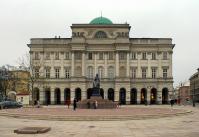In search of the past

Staszic Palace, fot. harum
Is the Staszic Palace home to the archives of the Association of the Polish Youth “Zet”, a pre-WWI clandestine organisation of Polish students across European universities? Experts, including Anna Lejzerowicz, Ph.D., of the Warsaw University of Technology Faculty of Civil Engineering have performed some early surveys.
“We have detected sites of GPR anomalies, meaning sites of an irregular structure with heterogeneities,” the WUT expert explains. “Thus, sites for further checks have been identified so as to find the buried archives of the Association of the Polish Youth “Zet”.
The ground penetrating radar or GPR was used as the survey method to provide fast and non-intrusive capture of high-resolution geophysical data.
What is this method about?
“In a GPR survey, a transmitting antenna emits pulses of electromagnetic energy in a known and defined frequency band,” explains Dr. Lejzerowicz. “Electromagnetic energy penetrates the object or surface surveyed and gets partly reflected and refracted and partly suppressed at a boundary between materials having different electrical properties.” Return pulses bounced back from such boundaries or objects are recorded on the surface by a receiving antenna and saved into GPR data acquisition software.
“The amplitude of the electromagnetic energy pulses is proportional to the reflection coefficient at the boundary of two different environments,” says Dr. Lejzerowicz. “Simply put you can say that the quality of data in a GPR image (radargram), i.e. the strength of reflections and amplitude are determined by the contrast of electrical properties between two materials; the greater the contrast, the more pronounced the reflections in a radargram.
A high frequency antenna was used in the surveys at the Staszic Palace. “The higher the antenna frequency, the lower the depth range of measurement, that is true, but the greater the resolution of the resulting images and this was exactly what we were after as the surveys were done on relatively thin room walls,” explains Dr. Lejzerowicz.
A joint project
The GPR method is commonly used in civil engineering, geotechnical engineering or archeology and is perfectly suitable for detecting buried infrastructure objects (e.g. piping) or voids in walls or other heterogeneities. That was exactly the case with surveying the rooms of the Staszic Palace.
“The archives of “Zet” are probably hidden somewhere in the underground of the Staszic Palace, walled up in a box or binder in a wall recess or concealed under the floor in one of the rooms,” says Dr. Anna Lejzerowicz. “Hence the GPR exploration of the pre-selected rooms in the underground of the Staszic Palace.”
The surveys were carried out by Anna Lejzerowicz, Ph.D. and Małgorzata Wutke, M.Sc., Eng. of TPA Sp. z o.o. under an agreement between the WUT Faculty of Civil Engineering and TPA Sp. z o.o. for research, education and human resources collaboration.
Young people of Community Primary School No. 1 in Gdynia helped with the work done on January 30, 2020.
Other events around the exploration exercise were a conference entitled “Secrets of the Staszic Palace” and an Operation Kutschera walking tour telling the story of that daring and successful attack of the WWII resistance forces. The event sponsors were the Bolesław Srocki Association, Community
Primary School No. 1 in Gdynia, In Gremio Association, Polish Academy of Sciences Archives in Warsaw, Polish Academy of Sciences Support Operations Department, Polish Academy of Sciences Institute of Archeology and Ethnology, Warsaw University of Technology Faculty of Civil Engineering, Gdańsk Museum and Arktour WHU.
Dr. Anna Lejzerowicz was a speaker at the conference. “I provided an overview of the GPR method and described its key assumptions and capabilities; I outlined the measurement methodology and the equipment used and showed sample survey results,” says the WUT researcher.
The surveys and conference are part of a long-term project in the search of the “Zet” Archives. The purpose is to find the Archives of the Association of the Polish Youth “Zet” and build public awareness around the ideals of this unsung clandestine organization whose members contributed greatly to Poland’s regaining independence. The signatories of a letter of intent for collaboration under the project are the Bolesław Srocki Association, In Gremio Association and Community Primary School No. 1 in Gdynia, Polish Academy of Sciences Archives in Warsaw, Polish Academy of Sciences Support Operations Department, Polish Academy of Sciences Institute of Archeology and Ethnology and Warsaw University of Technology Faculty of Civil Engineering.
“Surveys are intended to continue into new room once new locations are identified for checks,” says Dr. Lejzerowicz. “The WUT Faculty of Civil Engineering will certainly be part of further exploration efforts.”







